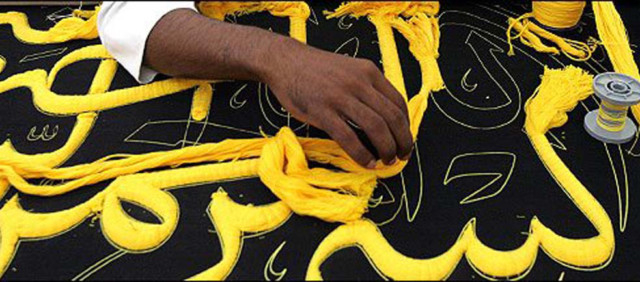
Dubai: The most revered place for Muslims in Makkah, Al Masjid Al Haram, has exceptional traditions including making the cloth of the Kaaba, the Qibla (direction) for millions of followers of the faith around the globe in their prayers five times a day.
Made of the best kind of pure imported silk, and embroidered with golden and silver thread, the cloth is changed once a year in a special ceremony. While the cloth is being changed, the verses from the Quran sewn on it – which are all related to Haj – don’t change, the general manager of Kiswah Al Kaaba (Kaaba cloth) explained.
Mohammad Bajoudeh told Gulf News in an interview from Makkah that making the cloth is by itself an exceptional tradition that Saudi Arabia feels honoured to have carried on for centuries now.
“This is a source of honour and pride for Saudi Arabia to produce the Kiswah,” he said. “This is a crown on the head of Saudi Arabia.”
Raw silk filament is imported from Switzerland or Italy, as well as the gold and silver threads that are used for embroidery, he said.
Once the boxes of white raw silk bundles arrive at the Kiswah factory, they are washed three times to remove the wax layer on them. Later the dyeing process is done, where the silk is coloured four specific colours: black, green, yellow and red, Bajoudeh said.
The black is used to make the outer cover of the Kaaba. The green and red are used for inside the Kaaba, where the silk covers half the length of the inner walls. The yellow is used as padding for the parts where verses from the Quran are embroidered with gold thread and etched on the fabric. Other embroidery in silver thread is padded with white cotton, Bajoudeh noted.
The new cover, which usually takes some eight months to produce from nearly 700 kilograms of raw silk, and nearly 150 kilograms of raw gold and silk thread, is put on every year on the ninth day of Dhul Al Hijja, which is Arafat Day, the climax of the Haj season, and one day before Eid Al Adha. The old cover is sent to a special warehouse, where it awaits a royal decree for its disposal.
Some reports note that usually the old cover is cut into pieces and presented as gifts to senior Islamic figures. In 1982, Saudi Arabia presented part of the Kiswah to the UN, where it is displayed in one of its main halls.
With an average annual cost of nearly 20 million Saudi riyals (Dh19.57 million), the Kiswah has been stitched in Saudi Arabia for decades.
“Until 1346 Hijri [1927 in the Gregorian calendar], Egypt used to make the Kiswah. But ever since, the late Saudi king and founder, King Abdul Aziz, issued an order to establish a factory to make the Kiswah near the Al Masjid Al Haram [Grand Mosque],” Bajoudeh said.
Today, the factory has nearly 150 employees, all of them from Saudi Arabia.
“Some have high passion and previous experience in this kind of work,” he added. “And for those who don’t, we offer intensive [training] programmes before they start working” on producing the piece of art. Usually, it is hand-woven and embroidered.
The Kaaba itself is washed twice a year. In Muharram, the first month of the Islamic calendar or Hijri calendar, and in Sha’aban, the month before Ramadan.
The Kaaba is usually washed in a special ceremony, with rose water, agar wood fragrance and Zamzam water.
Bajoudeh explained that the lower parts of the four walls of the Kaaba are what is usually washed.












